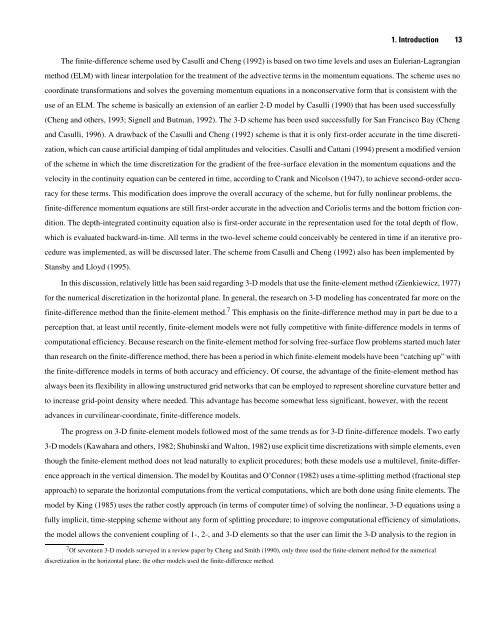A Semi-Implicit, Three-Dimensional Model for Estuarine ... - USGS
A Semi-Implicit, Three-Dimensional Model for Estuarine ... - USGS
A Semi-Implicit, Three-Dimensional Model for Estuarine ... - USGS
Create successful ePaper yourself
Turn your PDF publications into a flip-book with our unique Google optimized e-Paper software.
1. Introduction 13<br />
The finite-difference scheme used by Casulli and Cheng (1992) is based on two time levels and uses an Eulerian-Lagrangian<br />
method (ELM) with linear interpolation <strong>for</strong> the treatment of the advective terms in the momentum equations. The scheme uses no<br />
coordinate trans<strong>for</strong>mations and solves the governing momentum equations in a nonconservative <strong>for</strong>m that is consistent with the<br />
use of an ELM. The scheme is basically an extension of an earlier 2-D model by Casulli (1990) that has been used successfully<br />
(Cheng and others, 1993; Signell and Butman, 1992). The 3-D scheme has been used successfully <strong>for</strong> San Francisco Bay (Cheng<br />
and Casulli, 1996). A drawback of the Casulli and Cheng (1992) scheme is that it is only first-order accurate in the time discreti-<br />
zation, which can cause artificial damping of tidal amplitudes and velocities. Casulli and Cattani (1994) present a modified version<br />
of the scheme in which the time discretization <strong>for</strong> the gradient of the free-surface elevation in the momentum equations and the<br />
velocity in the continuity equation can be centered in time, according to Crank and Nicolson (1947), to achieve second-order accu-<br />
racy <strong>for</strong> these terms. This modification does improve the overall accuracy of the scheme, but <strong>for</strong> fully nonlinear problems, the<br />
finite-difference momentum equations are still first-order accurate in the advection and Coriolis terms and the bottom friction con-<br />
dition. The depth-integrated continuity equation also is first-order accurate in the representation used <strong>for</strong> the total depth of flow,<br />
which is evaluated backward-in-time. All terms in the two-level scheme could conceivably be centered in time if an iterative pro-<br />
cedure was implemented, as will be discussed later. The scheme from Casulli and Cheng (1992) also has been implemented by<br />
Stansby and Lloyd (1995).<br />
In this discussion, relatively little has been said regarding 3-D models that use the finite-element method (Zienkiewicz, 1977)<br />
<strong>for</strong> the numerical discretization in the horizontal plane. In general, the research on 3-D modeling has concentrated far more on the<br />
finite-difference method than the finite-element method. 7 This emphasis on the finite-difference method may in part be due to a<br />
perception that, at least until recently, finite-element models were not fully competitive with finite-difference models in terms of<br />
computational efficiency. Because research on the finite-element method <strong>for</strong> solving free-surface flow problems started much later<br />
than research on the finite-difference method, there has been a period in which finite-element models have been “catching up” with<br />
the finite-difference models in terms of both accuracy and efficiency. Of course, the advantage of the finite-element method has<br />
always been its flexibility in allowing unstructured grid networks that can be employed to represent shoreline curvature better and<br />
to increase grid-point density where needed. This advantage has become somewhat less significant, however, with the recent<br />
advances in curvilinear-coordinate, finite-difference models.<br />
The progress on 3-D finite-element models followed most of the same trends as <strong>for</strong> 3-D finite-difference models. Two early<br />
3-D models (Kawahara and others, 1982; Shubinski and Walton, 1982) use explicit time discretizations with simple elements, even<br />
though the finite-element method does not lead naturally to explicit procedures; both these models use a multilevel, finite-differ-<br />
ence approach in the vertical dimension. The model by Koutitas and O’Connor (1982) uses a time-splitting method (fractional step<br />
approach) to separate the horizontal computations from the vertical computations, which are both done using finite elements. The<br />
model by King (1985) uses the rather costly approach (in terms of computer time) of solving the nonlinear, 3-D equations using a<br />
fully implicit, time-stepping scheme without any <strong>for</strong>m of splitting procedure; to improve computational efficiency of simulations,<br />
the model allows the convenient coupling of 1-, 2-, and 3-D elements so that the user can limit the 3-D analysis to the region in<br />
7 Of seventeen 3-D models surveyed in a review paper by Cheng and Smith (1990), only three used the finite-element method <strong>for</strong> the numerical<br />
discretization in the horizontal plane; the other models used the finite-difference method.

















